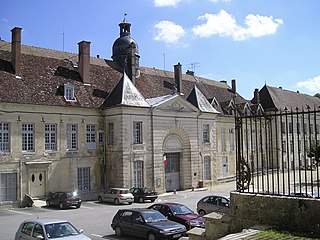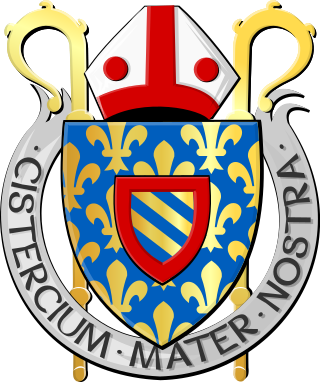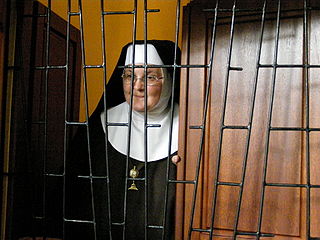
An abbey is a type of monastery used by members of a religious order under the governance of an abbot or abbess. Abbeys provide a complex of buildings and land for religious activities, work, and housing of Christian monks and nuns.

The Rule of Saint Benedict is a book of precepts written in Latin c. 530 by St Benedict of Nursia for monks living communally under the authority of an abbot.

Clairvaux Abbey was a Cistercian monastery in Ville-sous-la-Ferté, 15 kilometres (9.3 mi) from Bar-sur-Aube. The original building, founded in 1115 by St. Bernard, is now in ruins; the present structure dates from 1708. Clairvaux Abbey was a good example of the general layout of a Cistercian monastery. The abbey has been listed since 1926 as a historical monument by the French Ministry of Culture.

The Cistercians, officially the Order of Cistercians, are a Catholic religious order of monks and nuns that branched off from the Benedictines and follow the Rule of Saint Benedict, as well as the contributions of the highly-influential Bernard of Clairvaux, known as the Latin Rule. They are also known as Bernardines, after Saint Bernard himself, or as White Monks, in reference to the colour of the "cuculla" or cowl worn by the Cistercians over their habits, as opposed to the black cowl worn by Benedictines.

Netley Abbey is a ruined late medieval monastery in the village of Netley near Southampton in Hampshire, England. The abbey was founded in 1239 as a house for monks of the austere Cistercian order. Despite royal patronage, Netley was never rich, produced no influential scholars nor churchmen, and its nearly 300-year history was quiet. The monks were best known to their neighbours for the generous hospitality they offered to travellers on land and sea.

The Trappists, officially known as the Order of Cistercians of the Strict Observance and originally named the Order of Reformed Cistercians of Our Lady of La Trappe, are a Catholic religious order of cloistered monastics that branched off from the Cistercians. They follow the Rule of Saint Benedict and have communities of both monks and nuns that are known as Trappists and Trappistines, respectively. They are named after La Trappe Abbey, the monastery from which the movement and religious order originated. The movement first began with the reforms that Abbot Armand Jean le Bouthillier de Rancé introduced in 1664, later leading to the creation of Trappist congregations, and eventually the formal constitution as a separate religious order in 1892.

The Abbey of Our Lady of Gethsemani is a Catholic monastery in the United States near Bardstown, Kentucky, in Nelson County. The abbey is part of the Order of Cistercians of the Strict Observance, better known as the Trappists. Founded on December 21, 1848, and raised to an abbey in 1851, Gethsemani is considered to be the motherhouse of all Trappist and Trappistine monasteries in the United States. Gethsemani is the oldest Trappist monastery in the country that is still operating.

Cluny Abbey is a former Benedictine monastery in Cluny, Saône-et-Loire, France. It was dedicated to Saint Peter.

Mount St Bernard Abbey is a Roman Catholic, Trappist monastery near Coalville, Leicestershire, England, founded in 1835 in the parish of Whitwick and now in that of Charley. The abbey was the first permanent monastery to be founded in England since the Reformation and is the sole Trappist house in England. The monks brew the only Trappist beer in Britain.

Quarr Abbey is a monastery between the villages of Binstead and Fishbourne on the Isle of Wight in southern England. The name is pronounced as "Kwor". It belongs to the Catholic Order of St Benedict.

Casamari Abbey is a Cistercian abbey in the Province of Frosinone, Lazio, Italy, about 10 kilometers east-south-east of Veroli.

Enclosed religious orders or cloistered clergy are religious orders whose members strictly separate themselves from the affairs of the external world. In the Catholic Church, enclosure is regulated by the code of canon law, either the Latin code or the Oriental code, and also by the constitutions of the specific order. It is practised with a variety of customs according to the nature and charism of the community in question. This separation may involve physical barriers such as walls and grilles, with entry restricted for other people and certain areas exclusively permitted to the members of the convent. Outsiders may only temporarily enter this area under certain conditions. The intended purpose for such enclosure is to prevent distraction from prayer and the religious life and to keep an atmosphere of silence.

The Abbey of Fontenay is a former Cistercian abbey located in the commune of Marmagne, near Montbard, in the département of Côte-d'Or in France. It was founded by Saint Bernard of Clairvaux in 1118, and built in the Romanesque style. It is one of the oldest and most complete Cistercian abbeys in Europe, and became a UNESCO World Heritage Site in 1981. Of the original complex comprising church, dormitory, cloister, chapter house, caldarium, refectory, dovecote and forge, all remain intact except the refectory and are well maintained. The Abbey of Fontenay, along with other Cistercian abbeys, forms a connecting link between Romanesque and Gothic architecture.

The Abbey of Our Lady of the Mississippi is located near Dubuque, Iowa. The nuns there are members of the branch of the Order of Cistercians of the Strict Observance, commonly referred to as Trappistines. They are a part of the Catholic Church in the Archdiocese of Dubuque.

The Abbey of New Clairvaux is a rural Trappist monastery located in Northern California in the small town of Vina in Tehama County. The farmland, once owned by Leland Stanford, grows prunes, walnuts, and grapes that the monks harvest from the orchards and vineyards to sustain the community.

Bebenhausen Abbey is a former Cistercian monastery complex located in Bebenhausen, Baden-Württemberg, Germany. The complex is also the location of Bebenhausen Palace, a hunting retreat created and maintained by two Kings of Württemberg. The complex was named a historic monument in 1974.

The Abbey of Our Lady of the Holy Trinity was a Trappist Cistercian monastery in Huntsville, Utah, United States. They were Catholic contemplative monks of an enclosed religious order known as the Order of Cistercians of the Strict Observance (OCSO).

St. Andrew Abbey-Cleveland is a Benedictine monastery in Cleveland, Ohio.

Morimondo Abbey is a former Cistercian monastery located at Morimondo, a few kilometers south of Abbiategrasso in the Metropolitan City of Milan, Lombardy, northern Italy. The surviving structure is Romanesque and Gothic. It was founded in 1134 as a daughter house of Morimond Abbey near Dijon, from which it took its name.

Rawaseneng Monastery is a monastery complex of the Catholic Order of Cistercians of the Strict Observance (O.C.S.O.), popularly known as the Trappists, located in Temanggung Regency, Central Java, Indonesia. The monastery was officially established on 1 April 1953 as a daughter house of Koningshoeven Abbey in Tilburg, Netherlands. Apart from being a residence for the monks, there are also a church, prayer garden, retreat houses, coffee plantations, dairy farms along with the processing industries within the monastery complex. Ronald Bell, a pilgrim from the United States, shares his impression about this place, "You will get all the stages, praying, meditating, contemplating sacred readings, and working. All of those constitute an inseparable part of the experience." Not far from the monastery complex, it lies the Church of Santa Maria dan Yoseph as the center of the Rawaseneng Parish, just ahead of the Kindergarten and Elementary School of Fatima Rawaseneng which are managed by the Dominican nuns.















































